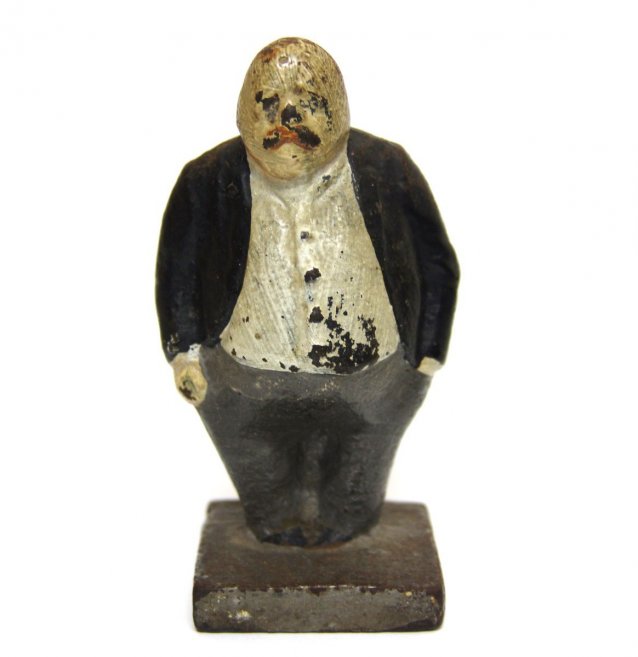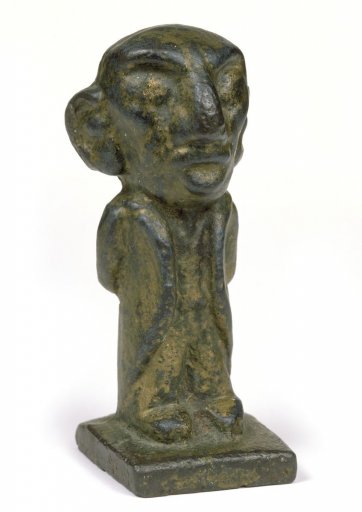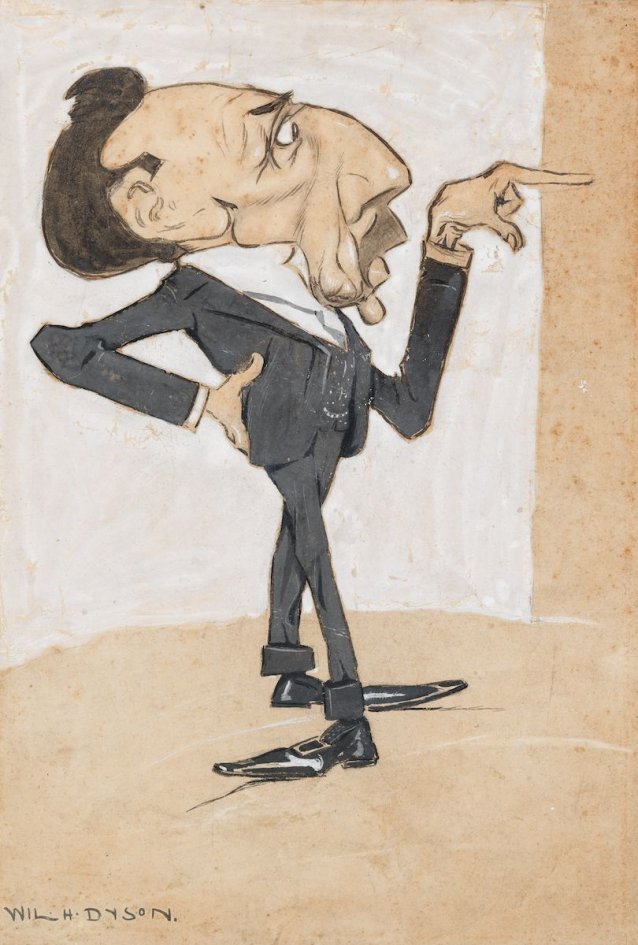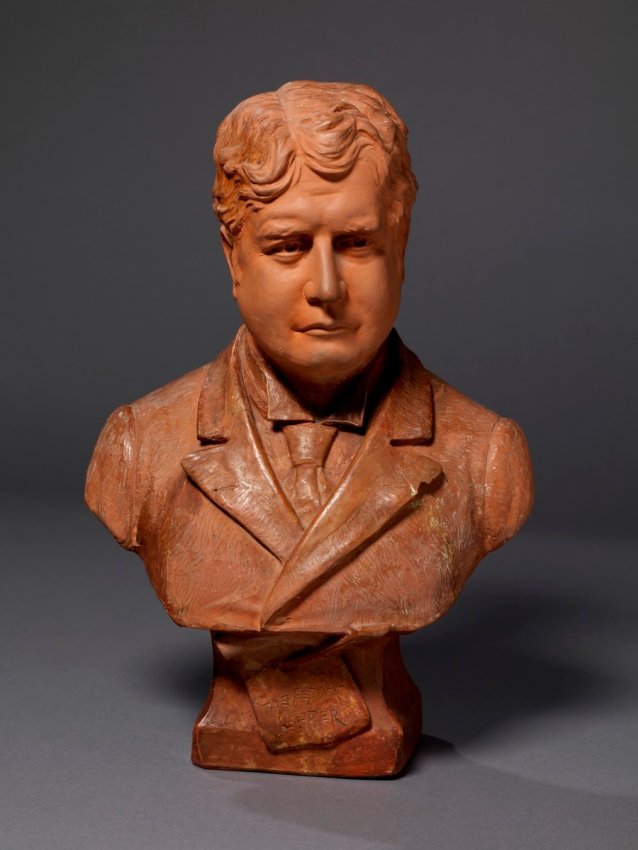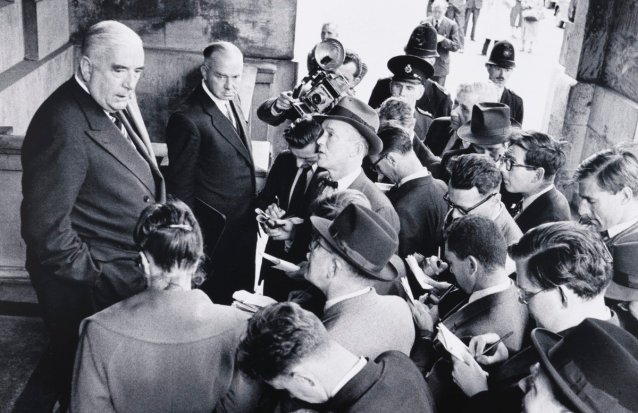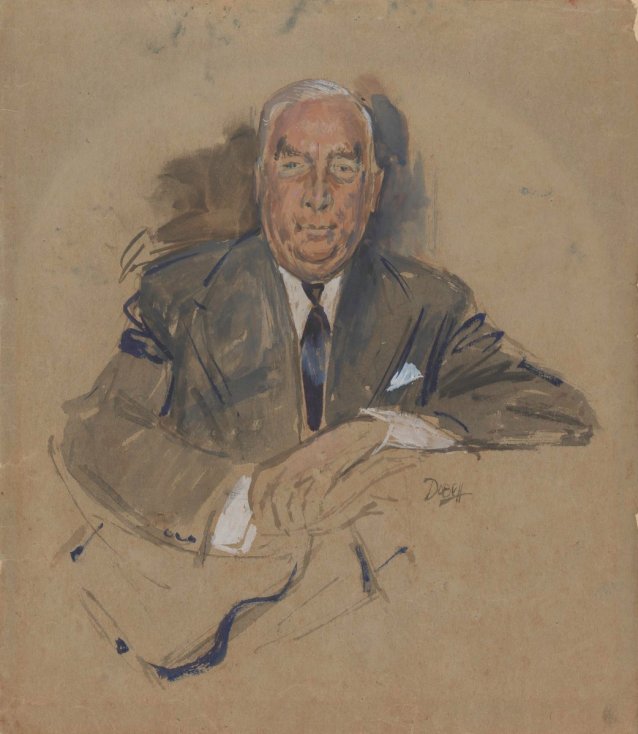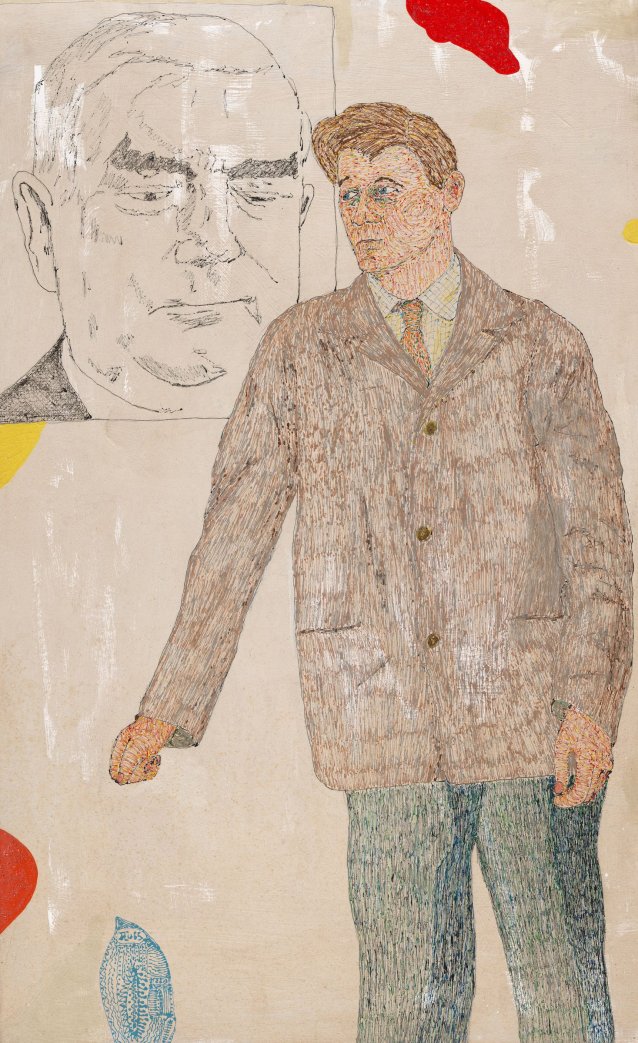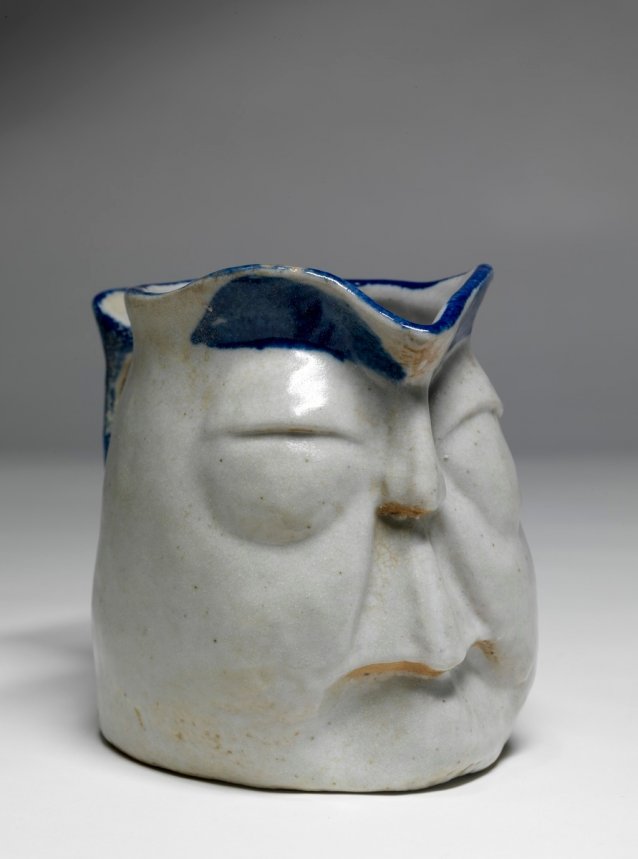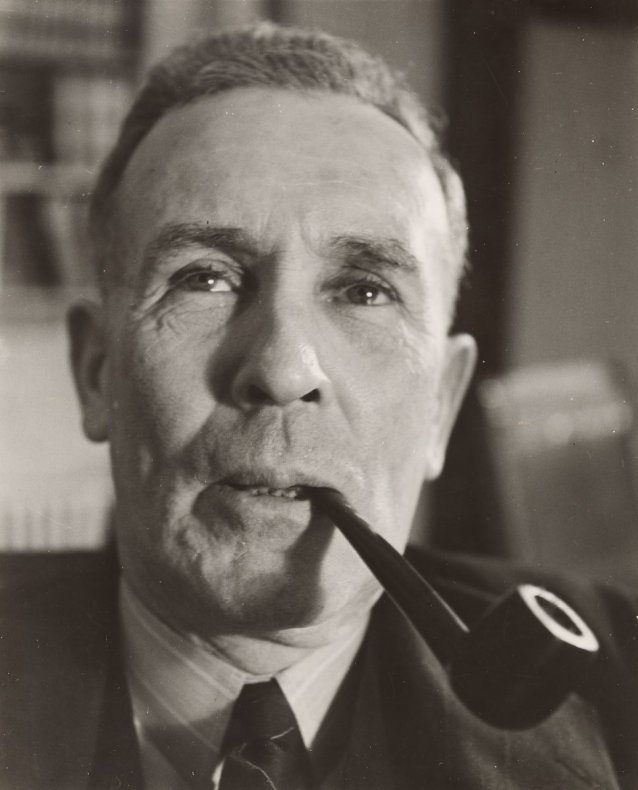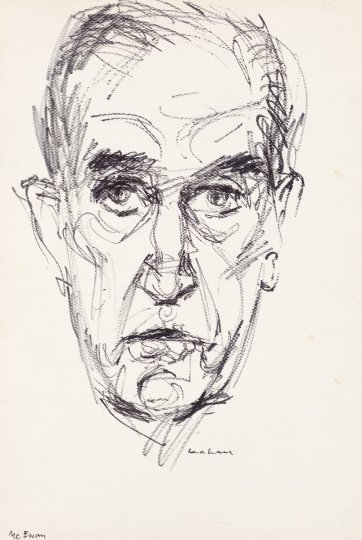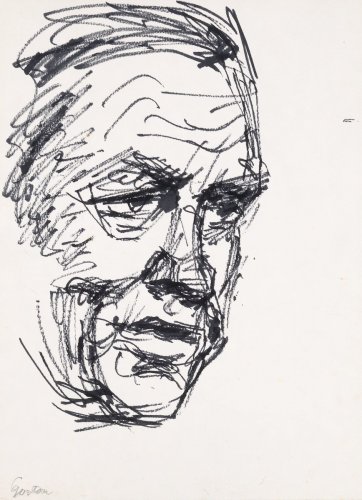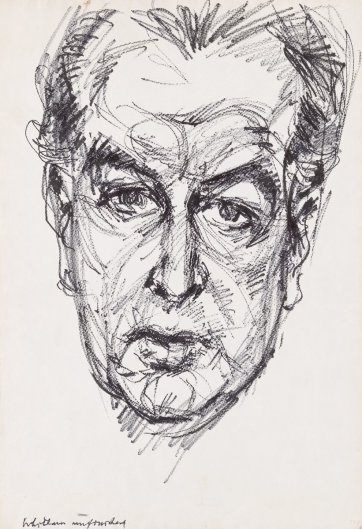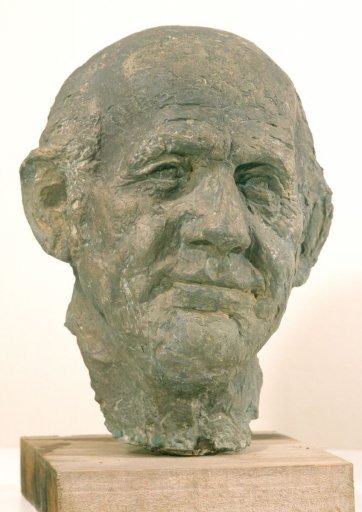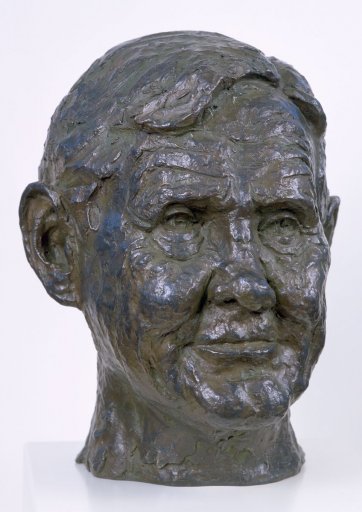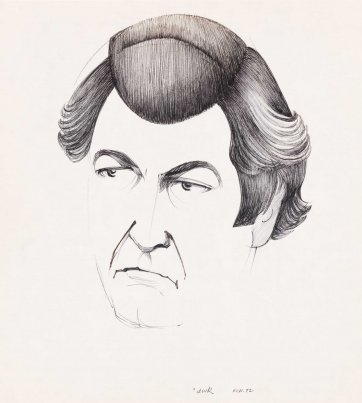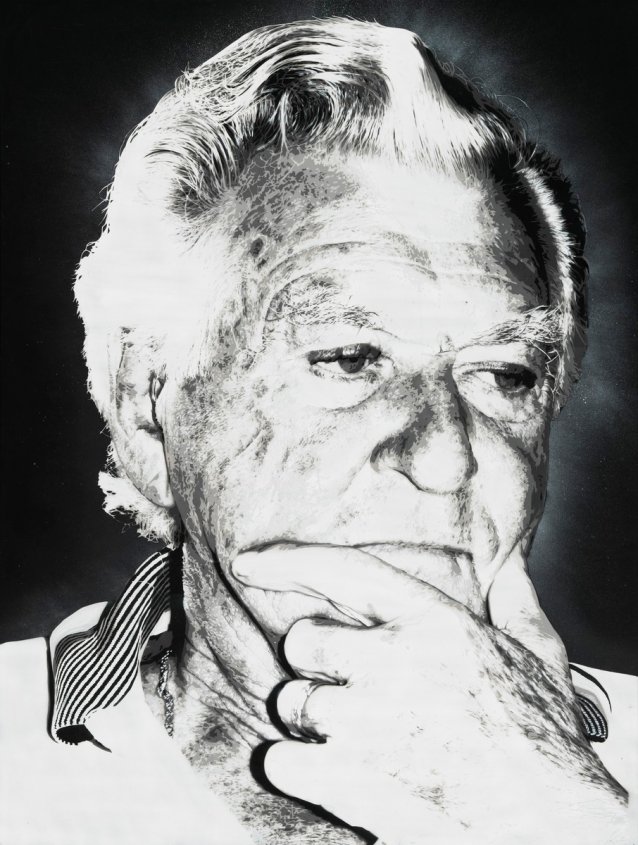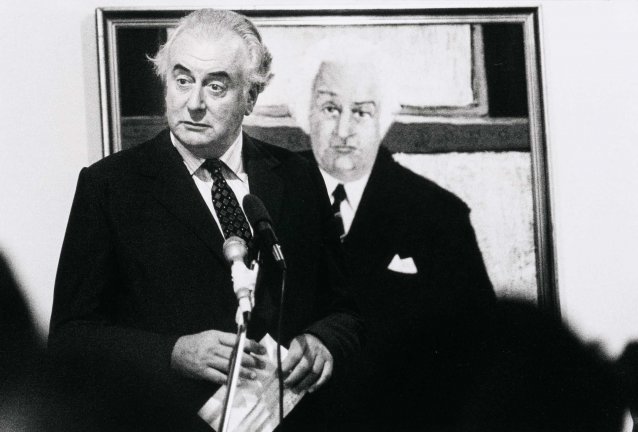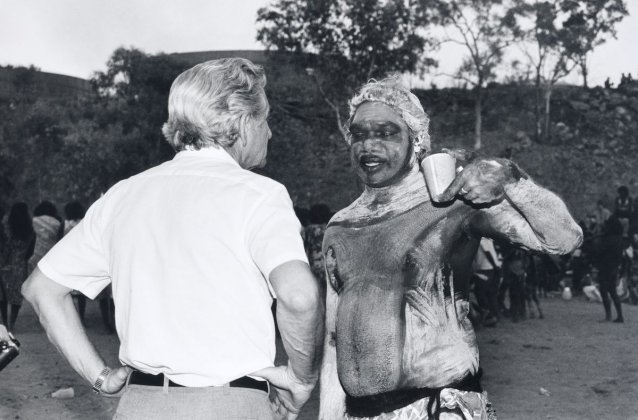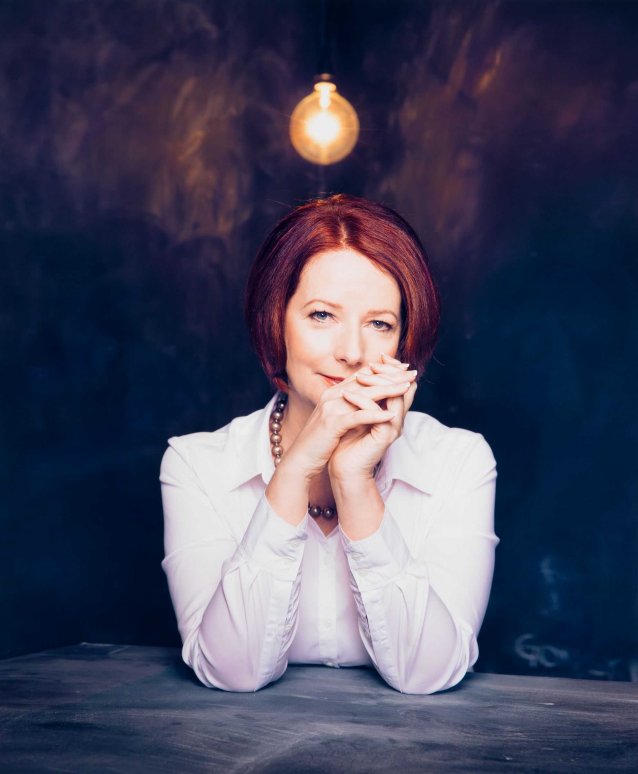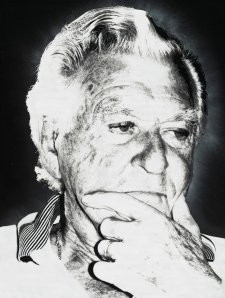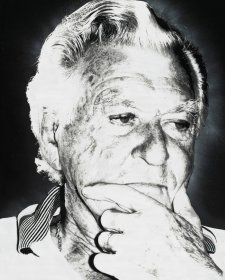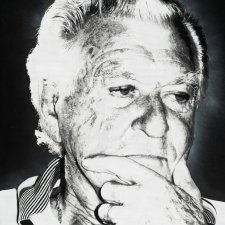Only seventeen of Australia’s thirty prime ministers to date are represented in the National Portrait Gallery’s collection. Their portraits have been acquired in random order, as opportunities for purchases or gifts have arisen. This is the first time in the Gallery’s 20-year history that the esteemed prime ministers’ portraits have been shown as a group. The contrasting sizes, moods and mediums of these portraits, and the different ways they have become available, reflect the exciting variety across the collection as a whole.
The miniature memento of George Reid came onto the market shortly before he departed Australia to become the country’s first high commissioner in London. Sydney’s Evening News carried an advertisement for the object on 12 January 1910:
‘Sir George Reid has been immortalised by being cast in a statuette of Lithgow iron. The statuette is 5 inches high. Farmer and Company, Ltd, are selling the statuettes, which can be used as a paperweight or ornament.’
Sir George Reid GCB GCMG PC KC was premier of New South Wales from 1894 to 1899 before serving as Australia’s fourth prime minister from 1904 to 1905. He was high commissioner to the United Kingdom from 1910 to 1916.
William Morris Hughes and George Reid were both popular targets for caricaturists - Hughes for the combination of his small frame, wizened face, large ears and pugnacious personality; and Reid for what colleague Alfred Deakin called ‘an immense, unwieldy jelly-like stomach' and ‘little legs apparently bowed beneath its weight’. Examples of the Hughes souvenir figure exist in various public collections. Some visitors have recalled ‘paperweights’ such as the Hughes and Reid statuettes being used by street newspaper vendors to secure their wares in a breeze.
The Billy Hughes bottle stop, manufactured by Mashman Bros, was purchased from a private vendor. William Mashman (1851-1912) and Henry Mashman (1856-1922), English-born potters and pipemakers, ended a partnership with James Sandison and formed the Sydney firm of Mashman Bros on their own in mid-1890. By the turn of the century they operated the Victoria Pottery, Willoughby and the Garrington Pottery, Auburn, turning out sewer pipes, sanitary fittings, terra cotta chimney pots, air bricks and louvres, garden edge and paving tiles, flower pots and agricultural pipes as well as vases, ginger beer bottles and miscellaneous household ornaments. In 1900 it was reported ‘Mashman Bros seem capable of doing almost anything in pottery work. The wheels are continually whirring merrily.’
William Morris Hughes CH KC was Australia’s seventh prime minister, from 1915 to 1923. For the first two years he was Labor prime minister; he continued in the job as leader of the new Nationalist party. He travelled to Europe during World War 1 to lobby for Australian exporters and ensure a political voice for Australia. He returned from a high-profile performance at the post-war peace conferences in the persona of ‘Billy’ Hughes, the ‘Little Digger’. Hughes holds the record for the longest-serving member of the House of Representatives, weathering a tumultuous 51 years and 7 months in the chamber.
Sir David Low, caricaturist, published his first cartoon in the British comic Big Budget at the age of eleven, while living in his native New Zealand. A year later, he was contributing two cartoons a week for the Christchurch satirical weekly, The Spectator. While working as the cartoonist for the Canterbury Times, he began sending examples of his work to a score of Australian editors each week. Eventually, in 1911, he landed a job at the Melbourne office of the Bulletin, for which he drew many political caricatures. The Billy Book (1918) was his second published anthology of caricatures. It sold 60 000 copies and famously invoked the wrath of its subject, Prime Minister William Morris Hughes. The success of The Billy Book brought Low a contract with the London Star. He left Australia in 1919 and worked until the end of his life in England. Knighted in 1962, upon his death he was described as the ‘dominant cartoonist of the Western world’.
Will Dyson, cartoonist, caricaturist, writer and draughtsman, was born near Ballarat and studied for a short time in Melbourne. Dyson’s first cartoon appeared in the Sydney Bulletin in 1897, when he also exhibited in the first show of the Society of Artists. In 1910 he married Ruby Lindsay, sister of his friend Norman, and they all went to London, but the two men soon quarrelled irrevocably. In early World War I Dyson’s cartoons became famous in London and he gained a large intellectual following. He was appointed an official war artist for the AIF in 1916. His Australia at War (1918) remains one of the most powerful tributes to Australian involvement in the conflict. After Ruby Lindsay died of flu in 1919 Dyson returned to Melbourne to work, but left Australia permanently in 1930, settling in London.
George Henry Dancey began his career as a stained glass designer in the UK and Australia, but ended it as the chief cartoonist for Melbourne Punch over 23 years to 1919. Made for the magazine, this fine and lively scene of Sir Edmund Barton, Australia’s portly first prime minister, propelled by Chris Watson, Australia’s third prime minister was captioned ‘THE REAL LEADER OF THE HOUSE: Labour Man Watson – “You lead all right, Edmund – with a little assistance.”’
After Federation in 1901, the Protectionists, under Sir Edmund Barton GCMG KC PC (1849 –1920), formed Australia’s first ministry. John Christian Watson, known as Chris Watson (1867–1941), was the first leader of the new Federal Parliamentary Labor Party, one of two opposition parties. Barton’s readiness to concede to Watson in parliament was lampooned in the press, including in Dancey’s cartoon.
Born in Valparaiso, Chile, Watson grew up in New Zealand and left school at ten years of age. He migrated to Sydney when he was nineteen and quickly became prominent in New South Wales politics and the Trade Union movement. Barton was born in Sydney, studied law, entered the NSW parliament in 1879 and, for most of the 1890s, was the leading campaigner for Federation. In 1903, Alfred Deakin began his first term as prime minister when Barton joined the High Court bench. The following year, Watson formed Australia’s (and the world’s) first Labor government. Although his government lasted only four months, Watson’s reputation as an amiable, articulate and reliable leader remained intact.
Under the headline ‘Mr Barton in Clay’, Sydney’s Evening News reported at the beginning of October 1898 ‘Mr Nelson Illingworth, the well-known sculptor, has just completed a half-life-sized bust in clay of Mr Edmund Barton MLA. The model was on private view at Mr Tom Roberts’s studio, in Vickery’s Chambers, yesterday afternoon. It is an excellent likeness of the federal leader, not only in facial expression, but in the general contour of the head, and the author proposes having a limited number of copies cast into bronzed terracotta for those of Mr Barton’s admirers who would care to possess so very striking a presentment of him.’ The Sydney Morning Herald reported that ‘The heavy cast of the face has been lightened, as in life, by the animation of the expression’ and that Illingworth proposed to start on a life-size version ‘almost at once.’
Nelson Illingworth trained in sculpture in England and worked as a modeller at the Royal Doulton potteries for nine years before moving to Australia. In the 1890s he set up the Denbrae Fine Art Pottery at Forest Lodge to make a range of flowerpots, fernpots and statuettes. He also made many heads, busts and statuettes, his subjects including his friend Henry Lawson, Cardinal Moran and Henry Parkes. Illingworth was one of the sculptors who worked on the striking façade of the Lands Department Building in Bridge Street, Sydney.
The Sydney Sunday Times reported in August 1895 ‘Mr Nelson Illingworth has executed a medallion portrait of the Premier. Friends of Mr Reid are using it to adorn their homes, and opponents as a target for pistol practice.’
Sir Robert Gordon Menzies KT AK CH PC QC (1894–1978) was Prime Minister of Australia for a total of nineteen years: from 1939 to 1941, as leader of the United Australia Party; and from 1949 to 1966, as leader of the Liberal Party, of which he was a founder.
In 1956, when President Nasser of Egypt ‘nationalised’ the Suez Canal, British Prime Minister Anthony Eden invited representatives from 18 nations to London to discuss how the international community might best respond. Australian Prime Minister Robert Menzies was in the USA when the crisis erupted. Due to proceed to Japan, the Philippines and Indonesia, he instead hurried to London, where he joined RG Casey, Australia’s minister for external affairs. The ‘Suez Conference’ took place in Lancaster House; the New York Times wrote ‘Suez Parley Setting is Mansion That Recalls Glory of Britain.’ Menzies weighed into the confrontation between Eden and Nasser, pledging Australia’s fervent support for the British Empire in the event of active conflict. Most commentators felt he went too far. Casey, embarrassed, tried to play Menzies’s martial rhetoric down.
David Moore (1927-2003), Australian-born international photojournalist, only ever held two exhibitions of portraits: in 1986, Australian Artists 1960-1985 in Melbourne and Sydney; and in 2000, David Moore: From Face to Face at the National Portrait Gallery – which acquired more than 100 of his photographs in 2001.
Sir William Dobell (1899-1970), painter, was apprenticed to an architect and studied art in Sydney before leaving Australia for Europe in 1929. On his return to Sydney after a decade he managed to impress conservative and modernist art factions alike. In World War 2, before being appointed an official war artist, he served in a camouflage unit and the Civil Construction Corps; great portraits, including The Billy Boy, arose from this experience. By 1959 he had won three Archibalds.
Time magazine commissioned Sir William Dobell to paint Menzies for the cover of its issue of 4 April 1960, which contained a very long article detailing ‘the speed with which Australia is coming of age’ under Menzies’s ‘decade of unabashed wooing of free enterprise’. (The piece quoted a senior Australian diplomat who asserted ‘Nowadays we can talk to anybody in the world without any sense of innate inferiority.’) Dobell had less than a fortnight in which to create the cover image, and was able to secure only two sittings with Menzies. Dobell often followed pencil drawings with quite detailed preliminary sketches in oils – such as this one, made in Canberra.
Richard Larter was born in London, where he encountered and was influenced by the new generation of young British Pop artists of the 1950s and early 1960s. After time in Algiers and North Africa, in 1962 he came to Australia. Over the 1960s he produced a body of work exploring social and political themes, often incorporating brightly coloured painted heads of celebrities, sex symbols, dictators, politicians and porn stars in challenging juxtaposition. For a decade from the 1980s Larter chose to exhibit only geometric, ethereal and glittery abstracts; elements of these can be seen in the figurative paintings made before and after. Settling in Narrabundah, Canberra, and working to a disciplined routine, Larter was prolific. A major exhibition of his figurative paintings, Stripperama, was held at the Heide Museum of Modern Art in 2002, and the National Gallery of Australia presented the comprehensive overview exhibition and scholarly catalogue Richard Larter: a retrospective in late 2008.
The National Portrait Gallery has five portraits by Larter, including this self-portrait with a ‘pin-up’ of Sir Robert Menzies KT AK CH PC QC, Australian prime minister from 1939 to 1941 and again from 1949 to 1966 - the period covering the Larters’ early years in Australia.
Richard Larter’s self-portrait with Robert Menzies was purchased with funds from the Basil Bressler Bequest. Basil Philip Bressler, who died in 2000, was a surveyor with an amateur interest in art and music. Raised by two aunts, he travelled to Europe in the 1950s and held several exhibitions of his abstract paintings in London. Although he sold many of his works, he turned to music as his primary creative outlet, becoming a keen violinist and performing for several years with the Hong Kong Philharmonic while working as a surveyor. He returned to Sydney in the 1980s and worked as a part-time sales assistant at David Jones while involved with chamber music groups. Quite unexpectedly, Bressler bequeathed more than a quarter of a million dollars to the National Portrait Gallery, stipulating that the money should be used for the purchase of works by living Australian artists. The Basil Bressler Bequest enabled the commission and purchase of many of the Gallery’s key works, encompassing a great variety of subjects, mediums and styles.
Les Tanner (1927-2001) and Gus McLaren (1923-2008) met after the war in occupied Japan, where they both drew cartoons for the British Commonwealth Occupation newspaper. After returning to Australia they both worked for a number of newspapers around the country, their careers coinciding for a time at Sydney’s Daily Telegraph. McLaren, a cartoonist, ceramicist and film animator, made the mould for the ‘Ming vase’ vessel from models made by Tanner.
Menzies’s nickname, Ming, originated in the Scottish pronunciation of his name, Ming-ees, which Menzies preferred to the usual pronunciation, possibly because it was the way the Queen said his name. A newspaper columnist extended the nickname to ‘Ming the Merciless’ after the Emperor in the Flash Gordon comic strip. ‘Fling out Ming’ subsequently became an election slogan; but Menzies was to retire, not to be voted out of office.
Joseph Benedict Chifley (1885-1951) was the 16th prime minister of Australia, from 1945 to 1949, and the last Labor prime minister before Gough Whitlam. His sudden death in 1951 overshadowed the celebration of the first fifty years of Federation. He lay in state in Kings Hall, Old Parliament House before being buried in Bathurst.
Because Ben Chifley, like John Curtin, died in office, few portraits of him exist. The National Portrait Gallery has no portrait of Curtin. Posthumous portraits are not commissioned by the Gallery, and only a handful – including John Webber’s portrait of James Cook, and William Dargie’s portrait of Charles Kingsford Smith and Charles Ulm - have ever been acquired.
Max Dupain OBE set up his photography studio in Sydney in 1934. Through the 1930s he took portraits and advertising shots, photographed ballet dancers and musicians for the ABC and gained exposure in the lifestyle magazine The Home. In the 1950s he turned increasingly to architectural photography, and from 1958 to 1973 he documented the construction of the Sydney Opera House. During the same period he began recording historic properties for the National Trust, and Canberra’s new buildings for the NCDC. In 1975 the touring exhibition Max Dupain - A Retrospective 1930-1975 brought Dupain’s name to the attention of the wide public, and turned The Sunbaker, taken nearly 40 years earlier, into a definitive Australian image.
David Moore worked in Sydney for four years to 1952, when the London bureau chief of Life magazine saw his portfolio of shots of Redfern and Surry Hills slums and suggested that Life and its sister publication Time could use him. For many years thereafter Moore worked freelance around the world, for publications including Time, Life, the New York Times, the Observer, National Geographic and Look. He returned to Sydney in 1958. Over the next 44 years he combined international with Australian assignments, and pursued private work.
Harold Holt CH (1908–1967) was Liberal Prime Minister of Australia from January 1966 to December 1967. In October 1966 Holt and his wife Zara played host to the first American president to visit Australia, Lyndon Baines Johnson, and his wife Ladybird. The trip sparked major anti-war demonstrations. Holt declared Australia’s willingness to go ‘all the way with LBJ’, but long before the war in Vietnam was over, on 17 December 1967, he went in for a swim off Cheviot Beach, Victoria, and never came out. His friend President Johnson flew to Australia again for his memorial service.
Louis Kahan was born in Russia to Jewish parents, and grew up in Vienna, where he trained as a tailor. At 20 he went to Paris, where he worked for the couturier Paul Poiret as a tailor and a designer. In 1939, he enlisted in the Foreign Legion; with the American Red Cross in North Africa, he made thousands of rather glamorous portraits of wounded servicemen. In Paris again, he was an illustrator for Le Figaro, but in 1947 he came to Australia, settling in Melbourne. Soon after, the editor of Meanjin asked him to make a series of pen and ink portraits of writers for the journal. Over the next fifty years his portrait drawings were hung in many Melbourne homes. He won the Archibald Prize in 1962 with a startling painting of Patrick White. Melbourne’s Jewish Museum held a multifarious Kahan retrospective in 1997.
The National Portrait Gallery has more than 60 works by Louis Kahan, most of them drawings. Eight were amongst the Gallery’s earliest purchases in 1998. Nine more were donated by the artist’s widow, Mrs Lily Kahan, in 2006. A few have come into the collection by purchase or donation from various individuals. In 2017 Mrs Kahan offered curators the opportunity to select desirable portraits from drawings remaining in the artist’s studio. A group of 43 was chosen, many of them drawn ‘from life’ as Kahan watched interviews on television current affairs programs. The Gallery already had portraits of Holt, Gorton (including a different Kahan drawing purchased in 2015) and Whitlam, but John McEwen was not represented in the collection.
John McEwen GCMG CH was caretaker prime minister until 10 January 1968. McEwen is the subject of one of Australia’s great political portraits, a painting by Clifton Pugh; but that work remains in private hands. Sir John Grey Gorton GCMG AC CH, Australia’s 19th prime minister, was elected Liberal Party leader on 10 January 1968. He left office voluntarily in March 1971. Gough Whitlam AC QC was 21st prime minister, holding office from early December 1972 until early November 1975. William ‘Billy’ McMahon came between them.
John Howard OM AC (b. 1939) was prime minister of Australia from early 1996 to late 2007. The Howards were crucial supporters of the establishment of the National Portrait Gallery and the construction of a dedicated building for the institution. The portrait of the couple was intended as the first of a series of portraits of Australian prime ministers and their spouses; but after 2000, for various reasons, this project did not proceed.
Josonia Palaitis trained as an art teacher in Sydney in the early 1970s. By the time of her first solo exhibition in 1981, she had exhibited in both the Archibald and Portia Geach competitions. Over the 1990s she won the people’s choice award of the Archibald three times and she won the Doug Moran National Portrait Prize in 1994. She had painted John Howard for the Archibald of 1979, and otherwise knew the Howards slightly as their children had been at the same preschool. When she was chosen for the commission, the three met at Kirribilli House to discuss her conception of the work, and she took many informal snaps of them in different areas of the grounds. Palaitis said that over her 650 hours’ work on the portraits, ‘foremost in my mind was to portray, in whatever way, a sense of relationship between the couple’, whom she found ‘sincere and unpretentious’.
Stanley Bruce, 1st Viscount Bruce of Melbourne CH MC PC was Australia’s eighth prime minister, from February 1923 to October 1929, and was Australia’s high commissioner in London from 1933 to 1945. The first inhabitant of the Lodge, he was also the first chancellor of the Australian National University and a founding member of the Royal Canberra Golf Club. He was Australia’s high commissioner in London from 1933 to 1945. Although he died there, his ashes were scattered from a plane over Lake Burley Griffin; he is the only prime minister whose remains ‘lie’ in Canberra.
In January 1929 Australian statesman Richard Casey, in London, wrote to the Australian prime minister, Stanley Bruce: ‘I see that you have agreed to the Bruce Toby Jug being sold to the public. I inquired of the potters about it and got two of them. I think they have turned out very well indeed. If you want any I can get them and send them out.’ This jug was one of a series of four by designer Percy Metcalf, produced between 1925 and 1928. Made at the Ashtead Pottery in Surrey, set up to afford employment to returned servicemen after the first world war, the jugs were issued in numbered limited editions – 1000 each for Stanley Baldwin and Lloyd George, and 500 each for Lord Hailsham and Stanley Bruce. This is number 1 of the original 500 Bruce jugs. The late National Portrait Gallery founding director Andrew Sayers and former historian Sarah Engledow spotted it in a vitrine in a large antique fair at Exhibition Park in Canberra on an autumn afternoon in 2006.
Barbara Tribe, born in Sydney, enrolled at East Sydney Technical College at the age of fifteen. In 1935 she became the first woman and the first sculptor to win the NSW Travelling Art Scholarship. Throughout the war she remained in England, working in the Inspectorate of Ancient Monuments before settling in Cornwall, where she taught for forty years. The year she died, aged 87, Tribe gave her contemplative head of Stanley Bruce, made after his prime ministership, to the National Portrait Gallery.
Victor Greenhalgh, sculptor and teacher, studied at the Ballarat School of Mines and the Workingmen’s College, Melbourne (later RMIT). He taught briefly at the Bendigo School of Mines, and for ten years from 1927 he taught at the Ballarat School of Mines. In 1938 his commissioned statue of King George V was unveiled in the main street of Ballarat. Having spent World War 2 as a director of camouflage, from 1955 to 1965 he was head of the school of art at RMIT.
Between 1959 and 1974 Victor Greenhalgh made busts of prime ministers Scullin, Forde, Menzies, Holt, McEwen, Gorton, McMahon and Whitlam for the Avenue of Prime Ministers in Ballarat’s Botanic Gardens. The three works by Greenhalgh in the collection of the National Portrait Gallery are studies for, or casts of, Ballarat’s busts.
His bust of Menzies was donated by the late ‘Peg’ Bunting, whose husband, Sir John Bunting, was assistant secretary to the Prime Minister’s Department from 1949 to 1953 and secretary to the cabinet from 1959 to 1975. Described by Menzies as the ‘prince of public servants’, from 1975 to 1977 he was Australia’s high commissioner in London. In retirement, he wrote RG Menzies – A Portrait (1988). Lady Bunting, a force, was a prominent and popular Canberran.
The bust of McMahon was a gift of Greenhalgh’s son and daughter-in-law, Paul and Wendy, residents of Griffith, ACT. Sir William McMahon was the 20th prime minister, in office from March 1971 to December 1972. The Liberal-Country coalition held government from 1949 until the end of 1972, when Gough Whitlam won the election for the Labor Party on the premise that ‘It’s time.’
Frank Hinder took some preliminary art training in Sydney before leaving in 1927 to study for seven years in Chicago, New York and Boston. He returned to Australia in 1934 advocating contemporary art and exploring ‘dynamic symmetry’. During the war he worked in the camouflage wing of the Department of Home Security, along with his wife, sculptor Margel Hinder, and painters William Dobell and Sali Herman. The Hinders spent 1942 in Canberra, constructing dummy aircraft and camouflage for hideouts, pipelines, ammunition dumps and factories. After the war Hinder continued to make many forms of art, and taught from 1948 to 1964 at first the National Art School, then the Sydney Teachers’ College. Hinder is represented in the National Gallery and many regional galleries.
The National Portrait Gallery has 18 portraits by Frank Hinder. The Hinders’ daughter, Enid Hawkins, donated six of his skilful portraits in 2003 – including Gough . . . Maintain the rage!.
Nine more Hinder drawings came into the collection in unusual circumstances in 2019. A group of the artist’s drawings in the collection of the Home of the Arts, Gold Coast (HOTA) had been deemed excess to contemporary requirements by that Gallery’s director, Tracy Cooper-Lavery. They had been given to HOTA by Patrick Corrigan AM, a tremendous benefactor of many Australian artists and galleries and a board member of, and donor to, the National Portrait Gallery. The National Portrait Gallery’s curators having chosen appropriate works from the group, Patrick Corrigan expressed his support for their de-accession from HOTA and their subsequent acquisition by the National Portrait Gallery.
Frank Hinder’s drawing of Paul Keating is the National Portrait Gallery’s only representation of Australia’s 24th prime minister. Its title refers to the fact that the 31-year-old Keating gained his first ministry when made minister for Northern Australia on 21 October 1975; but lost the job with the Dismissal three weeks later.
Robert James Lee Hawke AC GCL was Australia’s 23rd prime minister, from March 1983 to December 1991. He is the longest-serving Labor prime minister.
Luke Cornish, born and raised in Canberra, is a self-taught artist also known as ELK. After school he worked in construction jobs but found himself taking more and more days off to work on art projects. He fell into stencilling while studying horticulture and held his first exhibition, How you like me now bitch, in 2010. His portrait of Father Bob McGuire was a finalist in the 2012 Archibald Prize. That year, he went to Bob Hawke’s apartment overlooking Sydney Harbour to take photographs in preparation for this portrait, which was a finalist in the Moran Prize. In recent years Cornish has travelled thrice to Syria. Recently he parted from his commercial gallerists, telling journalist Sally Pryor ‘I’ve pretty much once again said goodbye to financial security in order to do what I want to do’.
Aside from a plastic fruit-juice dispenser in the shape of his head, this was the first portrait of Bob Hawke acquired by the National Portrait Gallery. It was purchased in Canberra’s centenary year, 2013, largely in recognition of ELK’s success.
Edward Gough Whitlam AC QC (1916-2014) and Sir John Kerr AK KCMG LSt J PC GCVO QC (1914-1991) were both lawyers. Kerr, son of a Balmain boilermaker, attended the University of Sydney, where he achieved first class honours and a University Medal. Admitted to the bar in 1938, he reached the rank of colonel during the war. By 1964 he was both President of the Bar Association and President of the Law Council of Australia. In 1972 he became chief justice of NSW, and in 1974, Australian governor-general.
On 11 November 1975 Kerr, having consulted the chief justice of the High Court, brought Whitlam’s term as Australia’s 21st prime minister to an abrupt end. In the preceding 18 months the government had been shaken by a series of scandals, resignations, sackings and reshuffles. In October 1975 the Opposition, led by Malcolm Fraser, used the Liberal majority in the Senate to block the supply of funds essential to the operation of the government. Aiming to force Whitlam to an early election, he justified his action on the grounds that the ‘incompetence, the damage, the failures of the worst government in our history cannot be ignored’. Whitlam retorted that it was unconstitutional for the Senate to attempt to determine who should hold government. The deadlock continued with the government’s money dwindling.
When Sir John Kerr dismissed Whitlam and appointed Malcolm Fraser caretaker prime minister, Whitlam stood on the steps of (Old) Parliament House, Canberra, and cried ‘Ladies and gentlemen, well may we say “God save the Queen”, because nothing will save the governor-general!’
Peter van der Veer, photographer, designer and painter, studied at Prahran College in the 1970s. In 1976 his work was exhibited in the Young Australian Avant-Garde exhibition at the Bibliothèque Nationale, Paris. Through the 1980s he worked in commercial portrait studios in Melbourne. Later in his life he lived in Geelong, where he mentored artists of all kinds and shared his interests in European philosophy, psychology, architecture and culture. He photographed Whitlam at a book launch, standing in front of Clifton Pugh’s portrait of Sir John Kerr, which was painted as the 1975 crisis developed.
Bill McAuley, veteran newspaper photographer, photographed Whitlam in the ABC television studios when he spoke to the Australian public post-Dismissal. He writes ‘He looked wistful and shell-shocked, but his indignation came through loud and clear as he cried foul.’ That evening, Whitlam called on the people to ‘maintain their rage’ at the Dismissal and their ‘enthusiasm’ for the election campaign to come. However, at the election held on 13 December 1975, Fraser’s Liberal / National Country Party Coalition won office by the biggest majority since Federation.
Mervyn Bishop, renowned as Australia’s first Aboriginal press photographer, was employed as a photographer for the Sydney Morning Herald and the Department of Aboriginal Affairs before turning freelance in 1986. In 1971 he was named Press Photographer of the Year. In 2017 the Art Gallery of New South Wales held a major retrospective, Mervyn Bishop, combining his best-known images with pictures he took of his family and other characters around Brewarrina, where he grew up.
Vincent Lingiari (1919–1988) was an Elder of the Gurindji people of the Northern Territory. In August 1966 he led a walkout of Aboriginal stockmen and their families who were employed in unsafe and inequitable conditions on Wave Hill cattle station, south-west of Katherine. Over time, a land rights claim evolved. A 1967 petition by Lingiari and his people was rejected. However, the Whitlam government, elected in 1972, negotiated a land claim between the traditional owners and the British pastoral company Vestey Ltd. Two new leases were issued; the Gurindji acquired title to 3 250 square kilometres, including the most sacred areas of traditional lands. Whitlam gave up the deeds to the traditional lands in a shed at Daguragu (Wattie Creek), Northern Territory in August 1975. Nugget Coombs had suggested to Whitlam that he should pour soil into the hand of Vincent Lingiari as he handed over the deeds to the Gurindji – a reversal of the gesture between John Batman and the Wurundjeri people as the ‘rights’ to the land now occupied by Melbourne were exchanged in 1835. Mervyn Bishop persuaded the protagonists to repeat the transaction in the open air.
Robert McFarlane, born in Glenelg, South Australia, began work in a small advertising agency, where his interest in photography was encouraged. In 1963 he moved to Sydney, where he began freelancing for magazines including the Bulletin, Vogue Australia and Walkabout and became editor of Camera World. In the early 1970s he travelled and worked freelance overseas, and from 1973 he took still photographs on many Australian film sets and theatre stages. A regular photography critic for the Australian and the Sydney Morning Herald, he has works in the National Gallery, the Art Gallery of New South Wales and the National Library as well as the National Portrait Gallery.
McFarlane photographed Whitlam and Hawke when Malcolm Fraser was prime minister. His term in the job fell between Whitlam and Hawke’s. Bob Hawke, the lithe figure on the right, first ran for federal parliament in 1963, but did not win a seat until much later. He was elected president of the Australian Council of Trade Unions (ACTU) in 1969, and in 1973 he became federal president of the Labor Party, too. In the spring of 1980, he resigned from the ACTU to win the seat of Wills. By February 1983 he was Labor Party leader. Australia’s 23rd prime minister, he led the party to victory for a record four terms, in 1983, 1984, 1987 and 1990.
Sue Ford, photographer, filmmaker and photo-media artist, was the first woman photographer to be given a solo exhibition at the National Gallery of Victoria. Making many key images exploring women’s everyday lives and the politics of representation in the 1970s, during the late 1980s Ford became increasingly interested in indigenous issues, race, representation and colonisation.
In 1988 Sue Ford attended the Barunga festival of culture and sports. There, then-prime minister, Bob Hawke, met with senior Aboriginal men including Gamatj clan leader Galarrwuy Yunupingu AM (b.1948). In 1963 Galarrwuy had helped his father, Mungurrawuy Yunupingu, draft the Bark Petition to federal parliament that launched the first native title case in Australia. He became chairman of the Northern Land Council in 1977 and was Australian of the Year for 1978. With other senior leaders, in 1988 he drew up the Barunga Statement, another proposal for Aboriginal self-determination. Hawke hung it in Parliament House on his last day in office. Yothu Yindi’s hit song ‘Treaty’ was a significant result of this encounter. There are photographs of Galarrwuy at separate meetings with Malcolm Fraser, Paul Keating, Kevin Rudd, Julia Gillard and Tony Abbott. His brilliant essay ‘Tradition, Truth and Tomorrow’ of 2008-2009 recounts his meeting with Hawke, other such ‘historic’ meetings, and their negligible outcomes.
Julia Gillard AC (b. 1961), the 27th prime minister of Australia, was the first, and is so far the only, woman to hold the job. She defeated then-prime minister Kevin Rudd in a leadership ballot in June 2010. In June 2013 she lost the leadership in a spill to Rudd, and resigned from Parliament the following day.
Peter Brew-Bevan is a prominent Australian portrait, fashion and music industry photographer. His first solo exhibition was curated by the National Portrait Gallery in 2005. Since then, he has several times featured in the National Photographic Prize and he was a key contributor to the exhibition PROMO: Portraits from prime time. The Gallery has twelve of his portraits.
According to Brew-Bevan, this is the last official portrait to be taken of Julia Gillard as prime minister. He writes ‘This image was taken on the Monday of the June long weekend, right when the grab for office began … she is an amazingly strong woman … what must have been going through her mind at the time of this photograph - still to allow her vulnerability to show through is quite remarkable and a true testament to her stoic nature.’ The photograph is part of a series that he took for author, journalist and public intellectual Anne Summers, who was the first person to whom Gillard granted an interview following her resignation, and whose many articles about Gillard are published on her website.
